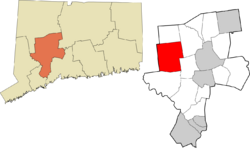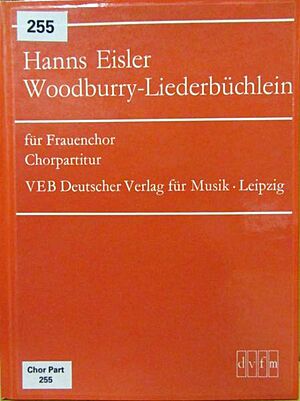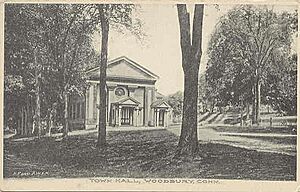Woodbury, Connecticut facts for kids
Quick facts for kids
Woodbury, Connecticut
|
||
|---|---|---|
| Town of Woodbury | ||
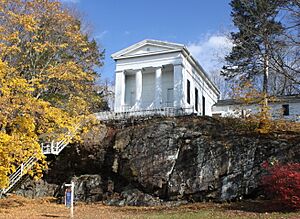
King Solomon's Lodge No.7, started in 1765
|
||
|
||
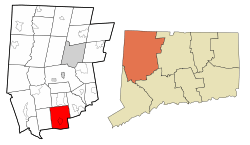 Litchfield County and Connecticut Litchfield County and Connecticut |
||
| Country | ||
| U.S. state | ||
| County | Litchfield | |
| Region | Naugatuck Valley | |
| Named | 1673 | |
| Government | ||
| • Type | Selectman-town meeting | |
| Area | ||
| • Total | 36.6 sq mi (94.9 km2) | |
| • Land | 36.4 sq mi (94.3 km2) | |
| • Water | 0.2 sq mi (0.6 km2) | |
| Elevation | 243 ft (74 m) | |
| Population
(2020)
|
||
| • Total | 9,723 | |
| • Density | 267/sq mi (103.1/km2) | |
| Time zone | UTC-5 (Eastern) | |
| • Summer (DST) | UTC-4 (Eastern) | |
| ZIP code |
06798
|
|
| Area code(s) | 203/475 | |
| FIPS code | 09-87910 | |
| GNIS feature ID | 0213540 | |
Woodbury is a town in Litchfield County, Connecticut, United States. It is part of the Naugatuck Valley Planning Region. In 2020, about 9,723 people lived here. The main part of town, called Woodbury Center, is a special area recognized by the U.S. Census Bureau. Woodbury was first started in 1673.
The center of Woodbury is special because of its many old buildings. These buildings line the road for about a mile. Important public buildings include the First Congregational Church (built in 1818) and the Old Town Hall (built in 1846). Other old churches like the United Methodist Church and St. Paul's Episcopal Church (1785) are also there.
One of the most interesting buildings is the Masonic Temple (built in 1839). It's a simple, wooden building with a Greek Revival style. What makes it stand out is where it's located. It sits high up on a cliff, and you have to climb many steps to reach it. You can see it from far away, and it looks amazing at night when lights shine on it. This temple reminds people of ancient Greek temples built on high places.
Many of the old houses on the main street were once homes. Later, they became antique shops. Because of this, Woodbury is often called Connecticut's "antiques capital." Woodbury is also one of two towns in Litchfield County that uses the 203/475 area codes.
Contents
Exploring Woodbury's Location
Woodbury is in the southern part of Litchfield County. It shares a border with New Haven County to the south. The town is about 10 miles west of Waterbury and 21 miles northeast of Danbury.
The town covers about 94.9 square kilometers (36.6 square miles). Most of this area is land, with only a small part (0.6 square kilometers or 0.2 square miles) being water. The main town center, Woodbury Center, is about 5.0 square kilometers (1.9 square miles) of land.
Woodbury is located in the valley of the Pomperaug River. This river is a branch of the Housatonic River. The Pomperaug River starts in Woodbury when two other rivers, the Nonnewaug River and the Weekeepeemee River, join together.
Main Areas in Woodbury
Woodbury has several smaller communities within it:
- Hotchkissville
- Minortown
- Neufa
- North Woodbury
- Pomperaug
- Woodbury Center
- Woodlake
Woodbury's Weather
Woodbury has a humid continental climate. This means it has warm summers and cold winters.
| Climate data for Woodbury, Connecticut | |||||||||||||
|---|---|---|---|---|---|---|---|---|---|---|---|---|---|
| Month | Jan | Feb | Mar | Apr | May | Jun | Jul | Aug | Sep | Oct | Nov | Dec | Year |
| Record high °F (°C) | 63 (17) |
67 (19) |
81 (27) |
93 (34) |
96 (36) |
96 (36) |
100 (38) |
98 (37) |
94 (34) |
88 (31) |
78 (26) |
68 (20) |
100 (38) |
| Mean daily maximum °F (°C) | 34 (1) |
37 (3) |
46 (8) |
58 (14) |
70 (21) |
78 (26) |
83 (28) |
81 (27) |
73 (23) |
62 (17) |
50 (10) |
38 (3) |
59 (15) |
| Mean daily minimum °F (°C) | 13 (−11) |
14 (−10) |
23 (−5) |
33 (1) |
43 (6) |
53 (12) |
58 (14) |
56 (13) |
48 (9) |
36 (2) |
28 (−2) |
19 (−7) |
35 (2) |
| Record low °F (°C) | −22 (−30) |
−18 (−28) |
−11 (−24) |
0 (−18) |
22 (−6) |
32 (0) |
38 (3) |
35 (2) |
23 (−5) |
14 (−10) |
5 (−15) |
−14 (−26) |
−22 (−30) |
| Average precipitation inches (mm) | 4.03 (102) |
3.3 (84) |
4.57 (116) |
4.29 (109) |
4.5 (110) |
4.2 (110) |
4.2 (110) |
4.44 (113) |
4.63 (118) |
4.44 (113) |
4.39 (112) |
4.17 (106) |
51.16 (1,303) |
| Source: The Weather Channel | |||||||||||||
Woodbury's Past: A Look at History
The first people to settle in Woodbury came from Stratford, Connecticut, in the early 1670s. Back then, "Ancient Woodbury" was much larger. It included the towns we know today as Woodbury, Southbury, Roxbury, Bethlehem, most of Washington, and parts of Middlebury and Oxford.
Two groups of settlers arrived from Stratford. One group was led by Reverend Zachariah Walker. The other group, led by Deacon Samuel Sherman, had permission to buy land from the local Native Americans. In early 1673, about fifteen families (around fifty people) arrived in this area, which was known as "Pomperaug Plantation."
In 1673, these first settlers wrote an agreement called the "Fundamental Articles." This agreement said that everyone who could be welcomed to the new settlement would be. It also stated that the costs of setting up the town would be shared. No one would get more than twenty-five acres of land or less than ten. The articles also set aside common land and land for future settlers.
The settlement was named Woodbury, which means "dwelling place in the woods." It officially became a town in 1674. Deacon and Captain John Minor was an important early leader. He was the first town clerk and, with Lieutenant Joseph Judson, served as the first representative for Woodbury in the Connecticut General Court. In 1751, Woodbury became part of Litchfield County.
On March 25, 1783, a group of ten Episcopal church leaders met in Woodbury. They chose Samuel Seabury to be the first American Episcopal bishop. He later became the second leader of the Episcopal Church in the United States.
The Woodbury Songbook
A German composer named Hanns Eisler came to the United States to escape the Nazis. He stayed in Woodbury for about three and a half months in 1941. He was a guest of Joachim Schumacher and his wife Sylvia, who were also German refugees. Joachim taught at the Westover School in Middlebury, and Sylvia taught piano.
Joachim encouraged Eisler to write 20 songs. These songs were based on 16 American children's poems and four German texts. The songs were for female voices and were good for a school choir. This collection was published as The Woodbury Songbook. In German, it was called Das Woodbury Liederbüchlein. The book included lyrics in both English and German. Interestingly, the name Woodbury was spelled wrong in the German title.
Woodbury's Population Over Time
| Historical population | |||
|---|---|---|---|
| Census | Pop. | %± | |
| 1820 | 1,885 | — | |
| 1850 | 2,150 | — | |
| 1860 | 2,037 | −5.3% | |
| 1870 | 1,931 | −5.2% | |
| 1880 | 2,149 | 11.3% | |
| 1890 | 1,815 | −15.5% | |
| 1900 | 1,988 | 9.5% | |
| 1910 | 1,860 | −6.4% | |
| 1920 | 1,698 | −8.7% | |
| 1930 | 1,744 | 2.7% | |
| 1940 | 1,998 | 14.6% | |
| 1950 | 2,564 | 28.3% | |
| 1960 | 3,910 | 52.5% | |
| 1970 | 5,869 | 50.1% | |
| 1980 | 6,942 | 18.3% | |
| 1990 | 8,131 | 17.1% | |
| 2000 | 9,198 | 13.1% | |
| 2010 | 9,975 | 8.4% | |
| 2020 | 9,723 | −2.5% | |
| U.S. Decennial Census | |||
In 2010, there were about 9,984 people living in Woodbury. There were 4,219 households, with 2,772 being families. The average household had about 2.48 people.
About 24% of the population was under 18 years old. The median age in Woodbury was 41 years.
Schools in Woodbury
Woodbury is part of the Region 14 School District. This district includes several schools:
- Nonnewaug High School
- Woodbury Middle School
- Bethlehem Elementary School
- Mitchell Elementary School
- STAR Preschool Program
Getting Around Woodbury
Transportation
U.S. Route 6 is the main road in Woodbury. It goes northeast to Watertown (about 7 miles) and south to Southbury (about 5 miles). Connecticut Route 64 is another important road. It goes east to Middlebury (5 miles) and Waterbury (10 miles).
Other roads in town include:
- Route 47, which goes northwest to Washington.
- Route 61, which goes north from the eastern part of town to Bethlehem.
- Route 132, which goes north from the center of Woodbury to Bethlehem.
- Route 317, which goes west to Roxbury.
Interesting Places to Visit
- Glebe House
- Jabez Bacon House
- Hotchkissville Historic District (a historic area)
- St. Paul's Episcopal Church
- The Soldiers Monument
- The Hollow Park
Famous People from Woodbury
Many interesting people have lived in Woodbury:
- Leroy Anderson (1908–1975): A famous composer who wrote "Sleigh Ride". He lived in Woodbury from 1948 until he passed away.
- Malcolm Baldrige (1922–1987): He was the 26th United States Secretary of Commerce. He lived in Woodbury until his death.
- Joe Beck (1945–2008): A talented jazz guitarist.
- Hayden Carruth (1921–2008): A poet and critic who grew up in Woodbury.
- Santino Ferrucci: A racing driver born in Woodbury in 1998.
- Alexander Hamilton (1847–1928): A rector (church leader) at St. Paul's Episcopal Church.
- Matthew Lyon (1749-1822): A U.S. Representative from Vermont and Kentucky.
- Kay Sage (1898–1963): A surrealist painter who lived in Woodbury.
- Henry Shelton Sanford (1823–1891): A diplomat and the founder of Sanford, Florida. He was born in Woodbury.
- Yves Tanguy (1900–1955): Another surrealist painter who lived in Woodbury.
- William Robert Taylor (1820–1909): A former governor of Wisconsin. He was born in Woodbury.
- Robert Templeton (1929–1991): An artist known for painting presidents and civil rights figures. He lived and worked in Woodbury.
- Rob Zombie: A musician and movie director. He lived in Woodbury for some time.
See also
 In Spanish: Woodbury (Connecticut) para niños
In Spanish: Woodbury (Connecticut) para niños



